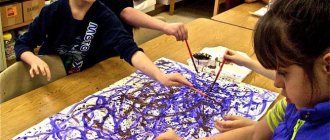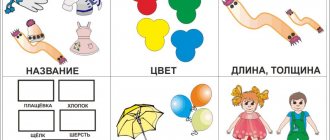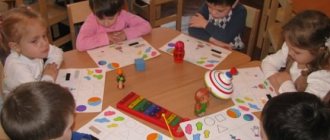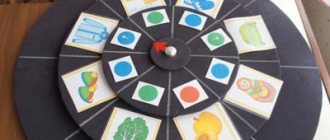Maintaining a nature calendar for preschoolers in the senior group and using it in work with seniors.
| Home page | Contacts | Random page Cars | Astronomy | Biology | Geography | A house and a garden | Other languages | Other | Computer science |
| Story | Culture | Literature | Logics | Mathematics | Medicine | Metallurgy | Mechanics |
| Education | Occupational Safety and Health | Pedagogy | Policy | Right | Psychology | Religion | Rhetoric |
| Sociology | Sport | Construction | Technology | Tourism | Physics | Philosophy | Finance |
| Chemistry | Drawing | Ecology | Economy | Electronics |
Educational and methodological material “Nature Calendar”
| September | |||||
| Days of the week | Weeks of the month | Live nature | |||
| 1 | 2 | 3 | 4 | ||
Legend
| Day of the week | Weather | Birds and insects | ||
Explanatory note.
Having studied the material of N.A. in distance courses. Ryzhova on environmental education of children, decided to adjust her work, diversify forms and methods.
All phenomena in nature occur in a certain sequence. Every year, in a certain order, the seasons come one after another, month after month. One of the available ways to convey the cycle of changing seasons and months to a child who is just beginning to understand the surrounding reality is to use a practical teaching method - modeling. Models help children learn the algorithm of natural changes in nature.
The nature calendar is a graphic model that reflects various, long-term phenomena and events in nature.
The purpose of working with the nature calendar is to ensure that children successfully acquire knowledge about the characteristics of natural objects, their structure, connections and relationships that exist between them.
An example of maintaining a calendar is a screen.
This calendar has three columns: “Days of the week”, “Weeks of the month” and “Wildlife”.
The first column, indicating the day of the week, is painted by the child in a certain color in accordance with the day on which the observation is carried out.
The second column is divided into four vertical stripes, indicating the weeks of the month. For observations, you can choose any of them, but the second or third is better. Thus, out of the four weeks presented in the calendar, only one is filled in. This makes it possible to show preschoolers how many days in a month observations were made, when they took place and when they will resume again.
Filling out the calendar, i.e. The modeling itself is carried out using icons and drawings in full accordance with observations. Every day, after a walk during which the children observed nature, under my guidance, they paint over the cell of the day of the week and depict the weather in the corresponding window with icons.
In the middle of the week, after examining the ground cover, tree stump and bush that are selected to be displayed on the calendar, preschoolers take a photo and the image is posted in the “Wildlife” section.
At the end of the week, after special observation of birds, insects and other seasonally appearing animals, children depict them with icons or drawings in the “Weeks of the month” column.
As a result, the completed calendar page has: colored cells for the days of one week, “weather” boxes filled with icons, photographs depicting a tree, bush, ground cover - everything corresponds to a specific moment in the state of nature.
The work is structured taking into account the specific content of the calendar and generalization tasks. First, I teach children to read the calendar, that is, to determine the semantic content by the visually presented symbolic designation, the ability to correctly navigate its plane; I direct the children’s attention to identifying patterns of change in nature.
With the help of questions, I organize and direct the course of children’s reasoning, sum up
them to highlight among the many specific representations of the semantic core. In this case, questions when discussing the calendar are considered as a means of developing and activating children’s logical thinking.
From a pedagogical point of view, the calendar model reflects. any of the developing natural phenomena or events should be considered as a visual aid created with the active participation of children based on their own impressions.
Introduction to the calendar as a system of time measures
A calendar is a number system for long periods of time . Long periods are divided into days, weeks, months, years and centuries.
Familiarizing children with the calendar in kindergarten will make it easier for them to navigate the surrounding reality , since the routine of life in kindergarten is built according to a specific plan associated with the days of the week. Children learn what days of the week what classes are held and psychologically prepare for them.
In order for the complex system of interconnected units of time to be clearly understood by children, it must be presented in the form of a calendar model . When introducing children to the calendar model, it is necessary to structure the work in such a way that the children actively interact with the materials of this model and, experiencing the duration of all presented periods of time, consciously master the standards of time.
The calendar model will help children visualize long periods of time: a week, a month and even a year. At one time, F.N. Blecher wrote that the tear-off calendar gives a clear idea that “days are passing,” “events are approaching,” a month has passed and a new one has begun. Waiting makes the child feel the passage of time; F.N. Blecher recommended using a calendar in working with children as the most visual device for measuring time. Children easily learn that a leaf is a day; in order to pick the next leaf, you have to wait a whole day.
Calendar meaning:
- gives a clear idea of the fluidity of time, the change of days, the irreversibility of time;
- waiting gives the child the opportunity to feel the passage of time.
When creating a calendar model as a visual aid, you can use the recommendations of F.N. Blecher. Calendar sheets measuring 9x6 cm must be secured so that they can be easily removed from the rods. On the front side, each piece of paper must have a number (number), the name of the day of the week and month. But since not all children in the older group can read, each calendar sheet must be marked with a strip of the appropriate color, so that each day of the week has its own color. Having remembered the color correspondence of the colored stripes to the seven days of the week, the stripes on the calendar sheet will be able to determine (“read”) the name of each day of the week. The reverse side of the sheet should remain blank. Hang the calendar on a small plank on the wall.
For removable calendar sheets, you need to make a box with 18 compartments according to the size of the sheets (3 rows of 6 cells). Every day, children will put sequentially removed sheets of paper into the cells of the bottom row - days of the week, 7 sheets of paper in each compartment of the bottom row.
| m | e | With | I | ts | s |
| m | e | With | I | ts | s |
| n | e | d | e | l | And |
1-7 8-14 15-21 22-28 29-31
7 sheets of paper - 7 days of the week in each department should create an image of the past week for children. At the end of the month, it is necessary to count the number of weeks, and the teacher also counts the number of days of the past month. Fold the leaves collected for the month into a stack, you can write the name of the past month and put it in the first (left) compartment of the top row of the box. So, 6 compartments of the top row will gradually be filled, and then 6 compartments of the second row will be filled in the same way. Thus, the stacks in the top two rows of the box will show the order of the months, and the bottom row will show the days of the week and weeks. At the end of the year, already in the preparatory group, the number of months in the year is calculated and the order in which they follow is determined.
Using the calendar model, the interrelation of all measures of calendar time is clearly reflected. Children themselves must take leaves from the calendar and add a week from days, a month from weeks, then determine the place of this month among others. The months are gradually and sequentially added up to form a year. At any time, children can go to the box and, using the calendar sheets laid out in it, determine how many days have passed since the beginning of the week, how many weeks have passed since the beginning of the month, how many months have passed since the beginning of the year, how many weeks have passed since the beginning of the month, how many months have passed since the beginning year, and from the empty cells determine how much is left before its end.
By performing all these actions, children gradually comprehend and realize the complex quantitative relationships between individual measures of time.
Work with the calendar begins with the New Year in the senior group. An introductory conversation is held.
Every day you need to draw children's attention to the current day. If a box with laid out calendar sheets is in a convenient place under the calendar, children will act with its sheets: independently consider the order of the days of the week, try to determine from the calendar how many days are left until the event they are interested in, find out how many months have passed since the beginning of the year, etc. d.
At the end of each month, it is necessary to have a short conversation with all the children about which month ended, how many weeks and days it had, all this is compared with the previous month. The number of months that have passed since the beginning of the year is determined and their name is specified, the month that began and its serial number are called.
In the preparatory group, children continue to work with the same calendar. In the first days of the new year, it is necessary to conduct the last general lesson on the calendar. It clarifies children's ideas about the calendar year. (How many months are there in a year? Which ones?) A visual material for the lesson will be a box with calendar sheets for the past year arranged in it by month: what holiday was celebrated recently? What year did it end? What year did it start? When did the new goal start? (What month? What date?) How many months were there last year? What is the first month of the year? Name and display all the months in the box. What are the winter months (autumn, summer, spring)? How many days are there in a month? How many days are there in a week?
Opening the calendar for the new year, the teacher recites the lines of a poem by S. Ya. Marshak: “Open the calendar - January begins.” The introduction of a new calendar for the new year should help children understand the fluidity, repeatability of the calendar year and its irreversibility (a past goal does not return, but a similar one, but a new one, begins).
Systematic work with the calendar in the senior and preparatory groups requires daily attention to its use and helps children develop knowledge not only about the current date, but also about the fluidity of time and its frequency.
Working methods:
- conversations (1 - introductory, 2 - introduction to the week, 3 - introduction to the month, 4 - final on generalizing the concept of “year”, each month one more conversation is held. To show that the month has passed and put the calendar sheets in the appropriate cell ).
— correlating the days of the week with a specific type of activity (classes, etc.)
- linking the names of the days of the week with a serial number or content
— modeling week, month, year
— did. games and game exercises: “Week, line up!”, “Put it in order” (from any day), “Name the day of the week”, “Find out by description”, “Find neighbors”, “Which day was missed”, “What happened, What will happen"
- characterize any day: month, date, day of the week, for example, January 15, Wednesday)
- reminder: what day is it today, what was it like yesterday, what will it be like tomorrow
— correlation of months with seasons, with month no.
- use of illustrative and literary material
46. Development of a sense of time in preschoolers.
Direct perception of temporal duration is expressed in our ability to feel it, directly evaluate it and navigate in time without aids. This ability is called the " sense of time ".
Modern working conditions require a person to be able to monitor the passage of time during activity, distribute it over time, respond to different signals at a certain speed and at specified time intervals, speed up or slow down the pace of their activities, and use time rationally. In all types of human activity, one way or another, time orientation and a sense of time are required. In turn, the sense of time encourages a person to be organized, collected, helps to save time, use it more rationally, and be precise. Time is a regulator not only of various types of activities, but also of human social relations.
In different types of activity, the “sense of time” acts as a sense of tempo, sometimes as a sense of rhythm, sometimes as a sense of speed. In the formation of this feeling, the accumulated experience of time differentiation based on the activity of many analyzers plays a certain role.
The sense of time develops and improves in the process of human life, as a result of specially organized exercises and mastering methods of assessing time. In such cases, it begins to play the role of a regulator of activity.





